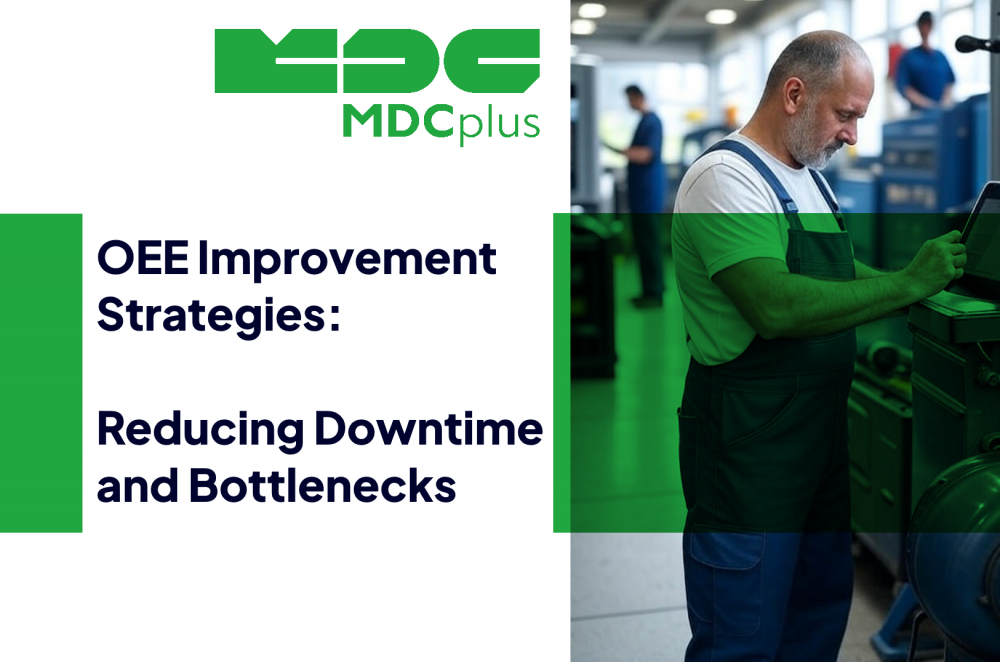No more manufacturing downtimes
Get started with your projectOEE Improvement Strategies: Reducing Downtime and Bottlenecks
Overall Equipment Effectiveness (OEE) is a critical metric for manufacturers, measuring the efficiency and productivity of equipment. Improving OEE involves addressing downtime and bottlenecks, which can significantly hinder production.
Understanding OEE and Its Importance
OEE is calculated as the product of three factors: Availability, Performance, and Quality. Downtime directly impacts Availability, while bottlenecks affect Performance. By targeting these areas, manufacturers can maximize throughput, reduce waste, and improve profitability.
Strategies to Reduce Downtime
Downtime, whether planned (maintenance) or unplanned (equipment failures), disrupts production. Here are effective methods to minimize it:
1. Implement Preventive Maintenance
- What It Is: Scheduled maintenance to prevent unexpected equipment failures.
- How It Helps: Regular inspections and servicing reduce the likelihood of breakdowns, ensuring consistent availability.
- Action Steps:
- Develop a maintenance schedule based on equipment manuals and usage patterns.
- Use predictive maintenance tools (e.g., IoT sensors) to monitor equipment health in real-time.
- Train staff to perform routine checks and address minor issues promptly.
2. Enhance Operator Training
- What It Is: Comprehensive training programs for operators to improve equipment handling and troubleshooting.
- How It Helps: Skilled operators can identify and resolve issues quickly, reducing unplanned downtime.
- Action Steps:
- Provide regular training on equipment operation and safety protocols.
- Encourage cross-training to ensure flexibility during staff shortages.
- Create quick-reference guides for common issues to speed up resolution.
3. Standardize Work Processes
- What It Is: Establishing consistent procedures for equipment setup, operation, and changeovers.
- How It Helps: Standardization minimizes errors and reduces setup times, keeping production on track.
- Action Steps:
- Document standard operating procedures (SOPs) for all equipment.
- Use checklists to ensure tasks are completed correctly.
- Regularly review and update SOPs based on feedback from operators.
4. Utilize Real-Time Monitoring
- What It Is: Deploying software or sensors to track equipment performance and detect issues instantly.
- How It Helps: Early detection of anomalies allows for quick intervention, preventing extended downtime.
- Action Steps:
- Invest in Manufacturing Execution Systems (MES) or Industrial IoT platforms.
- Set up alerts for abnormal conditions, such as temperature spikes or vibration.
- Analyze data trends to predict and prevent potential failures.
Strategies to Eliminate Bottlenecks
Bottlenecks occur when a process or machine limits the overall production flow, reducing OEE’s Performance component. Here’s how to address them:
1. Identify Bottlenecks with Data Analysis
- What It Is: Using data to pinpoint where delays or slowdowns occur in the production line.
- How It Helps: Understanding the root cause of bottlenecks enables targeted solutions.
- Action Steps:
- Map the production process to identify constraints (e.g., slowest machine or process).
- Use tools like value stream mapping or OEE software to track cycle times.
- Monitor work-in-progress (WIP) inventory to spot accumulation points.
2. Optimize Workflow and Layout
- What It Is: Reorganizing the production floor to improve material and information flow.
- How It Helps: A streamlined layout reduces delays caused by inefficient movement or setup.
- Action Steps:
- Conduct a layout analysis to minimize transport time between workstations.
- Implement lean principles, such as 5S, to keep workspaces organized.
- Rearrange equipment to create a smoother flow, reducing wait times.
3. Balance Production Lines
- What It Is: Adjusting workloads to ensure all processes operate at similar speeds.
- How It Helps: Balancing prevents overburdening one machine while others sit idle.
- Action Steps:
- Analyze cycle times for each process and redistribute tasks if needed.
- Use automation or additional resources for bottleneck processes.
- Test line balancing with simulations to predict outcomes before changes.
4. Upgrade Equipment or Technology
- What It Is: Replacing or upgrading outdated machines that cause bottlenecks.
- How It Helps: Modern equipment often operates faster and more reliably, boosting performance.
- Action Steps:
- Evaluate the cost-benefit of upgrading bottleneck machines.
- Consider automation for repetitive, slow tasks.
- Pilot new technology on a small scale before full implementation.
Integrating Strategies for Maximum Impact
To achieve significant OEE improvements, combine these strategies into a cohesive plan:
- Start with Data: Use OEE tracking software to measure baseline performance and identify priority areas.
- Prioritize Quick Wins: Focus on high-impact, low-cost solutions like operator training or process standardization.
- Invest in Technology: Gradually introduce IoT, automation, or MES to support long-term gains.
- Foster a Continuous Improvement Culture: Engage employees at all levels to suggest and implement ideas for reducing downtime and bottlenecks.
Measuring Success
Track OEE metrics before and after implementing changes to quantify improvements. Key indicators include:
- Reduced Downtime: Higher Availability scores.
- Faster Throughput: Improved Performance scores.
- Cost Savings: Lower maintenance and overtime costs.
- Employee Feedback: Operators report smoother workflows and fewer issues.
Conclusion
Improving OEE by reducing downtime and bottlenecks requires a combination of proactive maintenance, process optimization, and data-driven decisions. By implementing these strategies, manufacturers can enhance productivity, reduce costs, and maintain a competitive edge. Start small, measure progress, and scale solutions to achieve sustainable OEE gains.
About MDCplus
Our key features are real-time machine monitoring for swift issue resolution, power consumption tracking to promote sustainability, computerized maintenance management to reduce downtime, and vibration diagnostics for predictive maintenance. MDCplus's solutions are tailored for diverse industries, including aerospace, automotive, precision machining, and heavy industry. By delivering actionable insights and fostering seamless integration, we empower manufacturers to boost Overall Equipment Effectiveness (OEE), reduce operational costs, and achieve sustainable growth along with future planning.
Ready to increase your OEE, get clearer vision of your shop floor, and predict sustainably?
